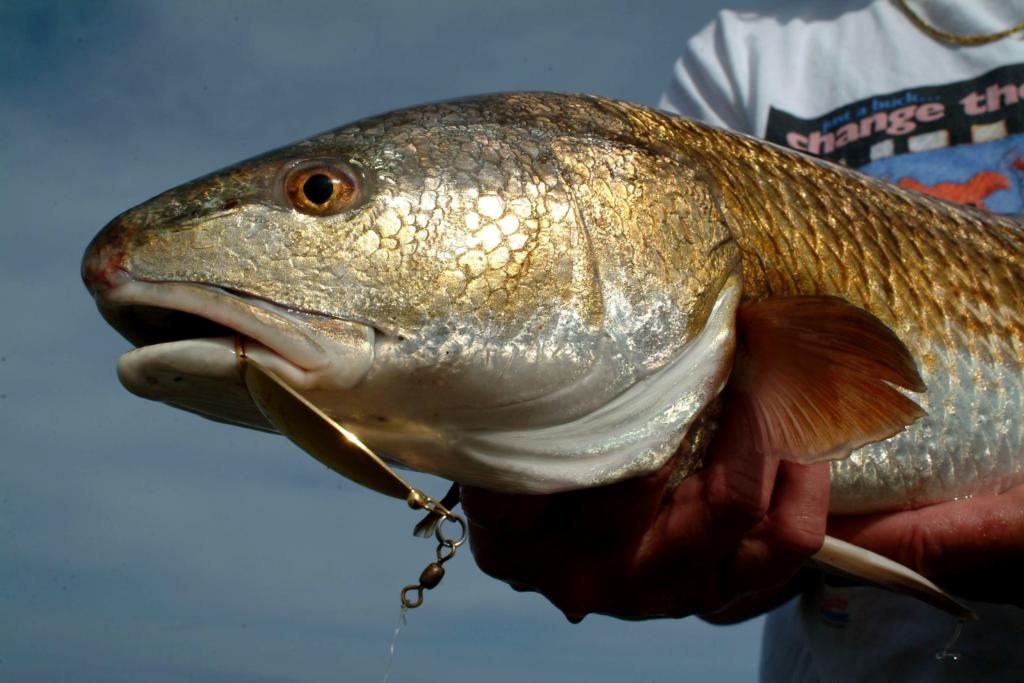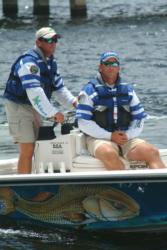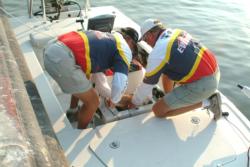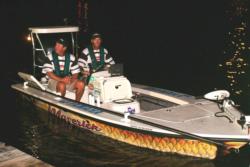FLW Outdoors seeing red
World’s leading marketer of fishing tournaments steps into redfish arena

One man’s trash is another man’s treasure – it’s an old saying that best describes the redfish’s rise to tournament-fishing stardom.
Thirty years ago, redfish were considered nothing more than a pesky bait-stealing member of the drum family, a nuisance to flats anglers fishing for more distinguished fish like speckled trout.
If an angler did catch a redfish, it ranked pretty low on the bragging list in conversations with fellow anglers.
As a kid, I can still remember the lowly regard for redfish among jetty anglers on the St. John’s River in Jacksonville, Fla.: “Some guys are having good luck with trout and flounder, but all we’ve caught is an old red drum.”
My, how times have changed.
These days, redfish are one of the most sought-after game fish on inshore waters. Images of “old red drum” now fill T-shirts and bumper stickers as universal symbols of flats anglers.
So how did this happen?
Today’s new breed of redfish anglers owes a lot to the tireless efforts of the Coastal Conservation Association – CCA – for the burgeoning redfish populations that currently cover coastal flats.
The CCA, a watchdog group of some 85,000 members dedicated to the conservation issues of our coastlines, is largely responsible for pulling the tarnished redfish from the trash-fish list and turning it into the heralded bronze beauty we know it as today.
In short, the CCA helped get the redfish recognized as a sport fish, and it was a major force in the commercial netting bans, which stopped the overharvest of mature redfish.
Since then, redfish stocks have soared across the Gulf of Mexico and up the East Coast – and so has an entire sport-fishing industry.
The early 1990s saw the first smattering of redfish tournaments – usually in the form of annual benefit events – in various coastal communities along the Gulf of Mexico.
By the end of the `90s, the Inshore Fishing Association – IFA – had taken the lead in organizing the first nationally recognized redfish tournament circuit.
The tremendous success of the IFA Redfish Tour helped kick the fishing market of the coastal flats into high gear while creating a new generation of professional anglers that specifically targeted redfish.
In 2003, the Redfish Cup took this relatively new sport to another level of exposure by putting Redfish Cup tournaments on ESPN.
Now FLW Outdoors is also seeing red. Starting in March, FLW Outdoors will bring its patented high-dollar payouts to the sport of competitive redfishing, thereby creating more opportunities for redfish anglers than ever before.
In the same way Roland Martin became synonymous with professional bass fishing in bass fishing’s early years, Greg and Bryan Watts, twin brothers from Florida, have become professional redfishing’s dream team.
The Watts brothers have captured virtually every title available in competitive redfishing, including the IFA Team of the Year in 2001, the Redfish Cup in 2003, the Redfish Cup Team of the Year in 2003, and now they have their sights sets on an FLW Redfish Series Championship.
“We’ve been waiting a long time for this,” said Greg Watts. “For the last five years, all we’ve heard is, `Next year redfishing is going to hit big,’ and now it feels like that year is finally here.”
“We all have seen what FLW has done for professional bass fishing, and now that FLW has stepped up to the plate in redfishing, it has really lit a fire under a lot of guys,” Bryan Watts said. “This will be the most exciting year of our fishing careers.”
This year, the Watts brothers will be fishing the FLW Redfish Series East Division and the Redfish Cup.
The crossover crowd
Like many successful redfish teams, the Watts brothers actually came from a bass-fishing background.
“We fished a lot of bass tournaments in the early `80s,” Greg said. “We did that for about nine years, and then we started looking for something a little different and saltwater tournaments fit the bill.”
The Watts have found tournament redfishing to be not much different than tournament bass fishing.
“The two are very similar,” Bryan said. “Much of the redfishing strategy we use came from our bass-fishing background. Anything a person has learned about bass fishing – from techniques to pattern fishing – can be applied in some way to redfishing.”
“If those bass boys want to come over here and play, I think they’ll find that they’re not that far out of the learning curve,” Greg added. “The biggest difference between bass and reds is that bass have more definable patterns and structure orientation, where as reds tend to roam a lot more. But other than that, much of the tackle, techniques and tournament strategy are derivatives of tournament bass fishing.”
Those who have followed professional bass fishing don’t have to look far down the FLW Redfish Series tournament list to see that some bass pros are also beginning to see red.
Wal-Mart FLW Tour pros David Walker of Sevierville, Tenn., Wes Thomas of Hanover, Ind., and Terry Segraves of Kissimmee, Fla., are all going to give redfishing a whirl this season.
“It’s a change of pace that I’m looking forward to,” said Segraves. “Fishing for reds is a lot of fun, and I think there is host of new opportunities coming with redfish; look at what the Watts brothers have done. This sport looks a lot like bass fishing did in its early days, so we really don’t know how big this thing could get.
“I know that a majority of redfishing is sight-fishing, but I’m kind of excited about taking other bass-fishing techniques and applying them to redfishing,” Segraves added. “Reds have got to live in other places than just up on those shallows flats, and I think anglers have just begun to discover the many different ways that redfish can be caught.”
While bass tournaments and redfish tournaments do share a lot of similarities, their formats do differ considerably. FLW Outdoors bass events have always been of a draw-type format where two strangers are drawn out to fish from the same boat; however, redfishing is a team sport, and the Redfish Series will be comprised of two-man teams.
“I really enjoy the team aspect of this sport,” Andrew Bostick of Marco Island, Fla., said. “Team dynamics are critical to success out here. You have to have someone you can count on in all situations.”
Bostick, along with team partner Mark Miller of Plainfield, Ind., won the Redfish Cup Team of the Year last year, and they also have an IFA Team of the Year trophy to their credit.
“Mark and I have been fishing together for about 12 years,” Bostick said. “After so many years of fishing together out of tiny skiffs, we’ve learned to work together like a symphony. Whenever one of us gets a fish on, the other knows exactly what to do without a word being spoken – it’s like clockwork – and it takes that special chemistry to do well.
“Mark and I are really excited about FLW coming into the sport,” Bostick added. “I don’t bass fish much, but I’ve made an intentional effort to follow FLW and the bass tours over the last few years, because those bass guys have set a blueprint for what’s to come in this sport.”
“Team fishing is something I’m going to have to get used to,” Segraves said. “Coming from a draw background, where we fish with someone different everyday, I’ve learned to be pretty tight-lipped about fishing information. It might take a tournament or two before I get used to divulging every detail of my practice to someone else.
“But the good thing about having a team partner is that you have someone else you can blame a bad day on,” Segraves joked. “You know how fishermen are – another excuse never hurts.”
Sarasota kickoff
FLW Outdoors will hold its first Redfish Series event in Sarasota, Fla., March 4 and 5 out of Centennial Park.
 Full-time guide and redfish pro Geoffrey Page of Venice, Fla., who considers Sarasota Bay his home waters, is looking forward to a challenging event.
Full-time guide and redfish pro Geoffrey Page of Venice, Fla., who considers Sarasota Bay his home waters, is looking forward to a challenging event.
“Sarasota Bay, itself, is really a small area, so a lot of teams will probably make long runs north to Tampa Bay or south to the Port Charlotte/Punta Gorda area,” Page said. “The run to Tampa Bay is not bad because it’s all protected – it takes about 30 to 45 minutes. But the run south can be a little more treacherous. The Intracoastal Waterway has too many long idle zones, so you have to run the open Gulf for a while and that can take a couple of hours or more if it’s rough.
“It’s going to be crazy down there on Saturday,” said Page, who fishes with Ed Zyak of Jensen Beach, Fla. “Hopefully we will do well and rock downtown Sarasota at Centennial Park.”
The Watts bothers think fishing in Sarasota will be tougher than normal because of the cooler weather.
“This is essentially still wintertime in Florida,” Bryan Watts said. “For guys eyeing the championship, this first event will probably be the toughest event of the Eastern Series because of the water temperatures – it won’t be like fishing in May or June.
“Like with wintertime bass fishing, reds are not as active this time of year,” he continued. “The schools are thinner, and they don’t feed as often during the day.”
“The water is real clear and the fish are spooky,” added Greg Watts. “It’s going to be an extra-low tide that first morning, so it’s going to be like fishing in a swimming pool. The key to this event is going to be patience – staking out and letting the fish come to you. We have already checked some of our A and B spots, and we would be real happy with four or five bites per day.”

